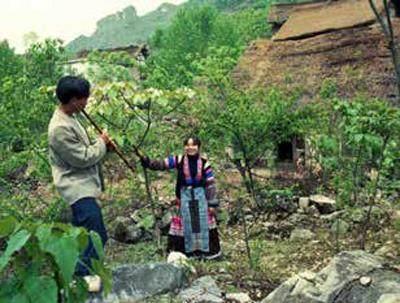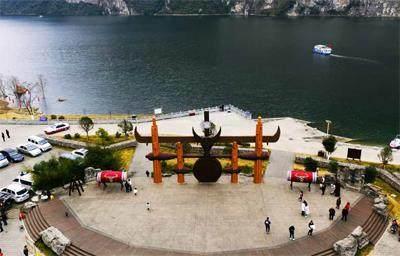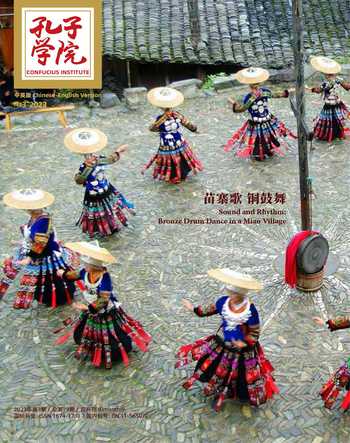三访化屋村
李贵云 赵相康






化屋村坐落在贵州省黔西市新仁苗族乡,原名“化屋基”,意为“悬崖下的村寨”。化屋村所处属于喀斯特地貌,被绵延无尽的一道道山谷封存在崇山峻岭之中,交通不便,土少石多,不宜耕种,村民出门主要靠山路和小木船。1998年,化屋苗寨还是一个极度贫困的山寨。当时的化屋村受限于自然条件,路不通、电不通、水不遥,“通讯靠吼,交通靠走”,村民之间虽然看得到对方,但见面要走上几个小时。
一访化屋村 黔路难于上青天
1998年4月8日,我受邀与朋友同行去化屋村采访苗族传统节日跳花节。当时,通往化屋村的路只有两条:一条是山路,需要徒手攀爬笋子岩的一条小路,山路窄处,要甩手扒着岩石上下,当地村民称之为“手扒岩”。这条路是化屋人祖祖辈辈出村的首选,但爬一次要几个小时。
另一条是水路。1995年东风湖水电站建成,这里的水情变得温和了许多,形成了著名的“乌江源百里画廊”风景区,村民们乘船出行有了可能。当时我进入化屋村走的是水路,从东风湖发电厂借来一條小船,顺着鸭池河进入了化屋村。
河边,是苗族同胞传统眺花坡的地方。三条横木拼搭成简易的门,门周围布满绿树红花,门上贴着红彤彤的对联欢迎贵宾。美丽的苗家姑娘们站在门前,笑脸盈盈地捧着大红花,端着酒杯,等待着宾客的到来。
河水边,两根电线杆之间拉着一条长十多米的横幅,上面写着“共庆苗家花坡节”。数百人站在花坡场的周围,等待着跳花坡话动的开始,还有许多村民将背篓放在地上,摆上自家的农产品,供大家选购。花坡节的仪式感很强,活动开始前三天,小伙子们到山上砍来一棵高大的常青树,剥去树皮,保留树冠枝叶,将其栽在花坡场上,并在树顶挂上贵重物品和—条红绸。节日当天,主持人先到花坡上生火,再在路边摆上迎宾酒,连放几十响礼炮,用来通知苗家男女老少入场。
化屋村苗族同胞的生活环境虽然不好,但他们依然保持着不屈不挠、乐观向上的精神。花坡场上一张张绽放的笑脸表达了苗族同胞对美好生话的向往。米酒的清甜、苗家人发自内心的欢快和热情,以及那种淳朴和对生话的热爱,让人记忆深刻。
悬崖之下,山石垒砌的民居屋顶上盖着茅草,房屋前的空地上苗家人正牵着耕牛在犁地,希望可以在自家院子里多种植一些苞谷,来年可以有个好收成。
东风湖水利工程锁住了奔腾不息的乌江洪流,形成了一个美丽的高原平湖,造就了神奇的“乌江源百里画廊”。东风湖喀斯特峡谷湖水清澈,倒影沉碧,宁静秀丽,两岸峰壁气势恢宏,断层壁画神秘多姿,鬼斧神工,风光迷人,形成了融高峡、平湖、溶洞为一体而雄奇壮美的山水画廊。
乌江在化屋村至清镇市暗流镇沙田村河边寨有一段河道长20千米,穿行于苗峙之间,河谷深切,水流湍急。两岸通行难,难于上青天。沙田村河边寨对面是黔西县铁石乡米新寨,为了解决两岸赶场物资交流,村民集资修建了鸭池河上的草绳溜桥。
溜绳是由兜山毛草加竹筋条混合编制、浸泡桐油后晾干而成,可用一年,第二年再换。草绳溜桥暂时解决了鸭池河两岸百姓赶集的困难,甚至接亲的轿子也是走的草绳溜桥。但随着国家通村公路建设步伐加快,以及索风营水电站2002年12月18日截流,水流上升将草绳溜桥淹没,政府修建了码头,使用了轮渡,草绳溜桥退出了历史舞台。
再访化屋村 天堑变通途
2011年5月传来消息,新仁乡至化屋村的通村公路建成了,时隔14年我叉踏上化屋村这片神奇的土地。
2016年7月,在距新仁乡化屋村直线距离几百米处的贵黔高速公路鸭池河特大桥建成通车,这是世界上跨径最大的钢桁梁斜拉桥,也是当时世界第二高的斜拉桥,目前其高度世界排名第五位。
2016年11月18日,成贵高铁鸭池河特大桥,世界上最大的跨径中承式空腹钢混结合提篮拱桥,正式合龙。成贵高铁贵州鸭池河特大桥是成贵铁路跨越鸭池河的一座高速铁路特大桥梁,位于黔西县铁石乡米新寨与清镇市暗流镇沙男村。这是鸭池河上的第五座桥梁。
在清镇市暗流镇沙田村河边的草绳溜桥和黔西县新仁乡龙井沟贵黔高速鸭池河大桥之间,有一处历史遗迹:1935年11月,中国工农红军红二、红六军团在贺龙、任弼时、萧克的领导下,长征途经清镇市卫城镇,先头部队战斗神速,控制了鸭池河渡口,两军团强行渡过了鸭池河。在“强渡鸭池河遗址”旁有一座始建于清代的鸭池河铁索桥,还有一座建于1997年的钢筋混凝土大桥——“鸭池河大桥”。鸭池河上飞架的五座桥梁是贵州交通变迁的一个缩影,见证了贵州城乡经济的发展和老百姓生活的变化。
有道是:“蜀道难,黔道更难。”近十年,贵州大力投资交通基础设施建设,目前已实现县县通高速公路。高速公路通了,高速铁路也通了,原来开车要12个小时才能到达的地方,现在乘动车1个多小时或走高速公路3个小时就可抵达。交通改变了贵州的面貌,带动了地方经济的发展,“人无三分银”的标签已经一去不复返了。
三访化屋村 苗家人的幸福生活
2021年2月26日,我第三次探访化屋苗察。化屋苗寨已经发生了巨大变化,成为贵州省级著名景区“乌江源百里画廊”旅游线上一颗璀璨的明珠。为了更好地保护长江生态环境,化屋苗察村民们放弃了传统打鱼营生,把打鱼船换成了旅游观光船,开发旅游项目,经营民宿,开设农家乐,实现了勤劳致富。
传承苗家传统工艺的化屋苗寨家庭作坊式民间蜡染和刺绣工艺规模不断扩大,形成商品化,推动了农民经济收入的增加。“……,传统的也是时尚的。它既是文化又是产业,它既能够弘扬民族文化、传统文化,又用产业来扶贫,用产业来振兴乡村,可以作出贡献。”在旅游开发的带动下,化屋苗索还种植大棚花卉、苗木。经过村民的努力,化屋苗寨年人均收入从1998年的214元增加到2019年的10 600元。到2021年3月,化屋村145户704人整体脱贫,过上了小康生话。
绣娘们则以针为笔,用一双双巧手在布匹上书写新的锦绣生活。她们用指尖的银针改变自己的生活,绣出家庭团圆、国家富强的景象,将大山深处的苗绣文化与现代时尚结台,让苗绣走出国门,为乡村振兴作贡献。
Three Visits to Huawu Village
Huawu Village is located in Xinren Miao Township of Qianxi City,Guizhou province .Its original name was huawuji meaning “village underthe cli ”. The village is situated in akarst landscape, surrounded by valleysand di cult to access. Adding to the dif- culties of life in the village is the scarcityof arable land caused by an abundance ofrocks and a shortage of soil. The villagers could once only rely on the mountainroads and their small wooden boats for transportation.
This was Huawu Miao Village in1998, an extremely impoverished mountainhamlet. Given its limited naturalconditions — with no accessible roads,electricity or water——communication and transportation were both challenging.The mountain roads were so rugged and long that while the villagers could see each from a distance,a meeting could mean hours of hiking.
The First Visit: A Toilful Journey
On April 8th, 1998, I was invited by a friend tovisit Huawu Village and report on the Miao people’straditional festival, Jumping Flower Festival. At thattime, there were only two routes to the village: one wasa mountain road which required visitors to literallyclimbing up one steep rock a er another on a narrowpath called “Hand-Scraping Rock”. This road was infact the preferred route for generations of Huawu villagers,even though it involved hours of climbing.
The other route was a waterway. After the completionof the Dongfenghu Hydroelectric PowerStation in 1995, the water in the region becamecalmer, which has not only created the famousWujiangyuan Hundred-Mile Gallery Scenic Area, butalso allowed villagers to travel by boat. At that time, Itook the water route. I traveled along the Yachihe Riverto reach the village on a small boat borrowed from theDongfenghu Power Station.
Along the riverbank was the traditional venuefor the Miao Flower-jumping. There was a makeshiftgate made from three horizontal wooden bars piecedtogether. Red couplets with welcoming words wereattached to the gate, which was surrounded by greentrees and red flowers. Beautiful Miao girls stood infront of the gate, holding large bouquets of red owersand cups of wine, waiting for guests to arrive.
Between two electric poles on the river was along banner that read “Celebrating the Miao FlowerFestival”. Hundreds of people stood around theflower mound, waiting for the start of the event.Many villagers also put baskets of their produce onthe ground for everyone to choose from. The FlowerjumpingFestival had a strong ceremonial sense. Threedays before the start of the event, young men wouldgo up the mountain to cut down a tall evergreen tree.They would peel o the bark, keep the crown branches,plant it on the flower mound and hang valuableitems and a red silk scarf on top of it. On the day of thefestival, the host would make a bonfire on the flowermound and set up an inviting wine station by theroadside. He would also set o dozens of recrackersto notify the villagers to enter the venue.
Although the living conditions in the village wereless than favorable, the Miao people of Huawu stillmaintained an indomitable and optimistic spirit. Onthe ower mound, from their smiling faces, I could seetheir yearning for a better life. I was indeed impressedby the sweet taste of rice wine, the genuine andheartfelt joy and enthusiasm of the Miao people, andtheir simple love for life.
Below the cliff were homes built of stones andmountain rocks, with thatched roofs made of grass. Isaw the villagers plowing their elds with oxen in frontof their houses. They were expecting a better harvestnext year, growing more corn in their yards.
The Dongfenghu Water Control Project sloweddown the surging Wujiang River, creating a beautiful lakeon a plateau as well as the magnificent “WujiangyuanHundred-Mile Gallery”. The water in the karstcanyon of Dongfenghu is clear and green, tranquiland beautiful, with majestic peaks on both sides andcolorful paintings like cli walls. It is a stunning andbreathtaking landscape where high cliffs, calm lakes,and water-eroded caves are found.
A 20-kilometer section of the Wujiang Riverpassed from Huawu Village to Shatian Village in AnliuTownship, Qingzhen City. With the Miao Mountainsstanding tall on the sides, the valley was deep, andthe water was once turbulent, which made transportationextremely di cult for the people living onthe banks. Across from Shatian Village is MixinzhaiVillage of Tieshi Township, Qianxi County. To assistthe exchange of goods and materials between the twobanks, the villagers raised funds to build a grass-ropesuspension bridge over the Yachihe River.
To make the rope, workers combined the grassfrom Doushan Mountain with bamboo strips, soakedthem in tung oil and dried them in the sun. The ropewould last for a year and then be replaced the nextyear. The bridge temporarily mitigated the transportationdi culties of the people living on both sides ofthe Yachihe River who wanted to go to the fair. At thattime, even the sedan chairs carrying young brides hadto cross such a bridge to reach the other bank. Withthe accelerated construction of roads and the completionof the Suofengying Hydroelectric Power Stationon December 18th, 2002, the rising water level submergedthe bridge. The government then built a dockand launched ferry services. The grass-rope suspensionbridge eventually became history.
The Second Visit: Now Reachable!
In May 2011, upon hearing that the village road from Xinren Township to HuawuVillage was completed, I decided to set foot on this magical land once again after 14years.
In July 2016, the Yachihe Bridge of Guiyang-Qianxi Expressway, located just a fewhundred meters away from Huawu Village, was open to traffic. The bridge was theworld’s largest long-span steel truss cable-stayed bridge, and at the time the world’ssecond highest cable-stayed bridge. Currently, its height ranks fifth in the world.
On November 18th, 2016, the Yachihe Bridge of the Chengdu-Guiyang HighspeedRailway, which is the world’s largest long-span half-through reinforced concretevierendal X-arch bridge, was officially completed. The bridge, crossing the YachiheRiver, connects Mixinzhai Village, Tieshi Township, Qianxi County, and Sha’nan Village,Anliu Township, Qingzhen City. It is the h bridge built on the Yachihe River.
There is a historical site located between the grass-rope bridge of ShatianVillage in Anliu Township, Qingzhen City and the Yachihe Bridge on the Guiyang-Qianxi Expressway in Xinren Township, Qianxi County. In November 1935, underthe leadership of He Long, Ren Bishi and Xiao Ke, the second and six regimentsof the Chinese Red Army passed through the town of Weicheng in QingzhenCity during the Long March. The vanguard troops quickly took control over theYachihe crossing, and the two regiments crossed the river despite all odds. Nextto the “Yachihe River Crossing” site, there is an iron chain bridge built during theQing Dynasty, as well as a reinforced concrete bridge named “Yachihe Bridge” thatwas built in 1997. These five bridges together embody Guizhou’s transportationchanges, witnessing its economic development and the changes in local people’slife.
There is an old Chinese saying that goes:“The road to Shu (Sichuan) is difficult, butthe road to Qian (Guizhou) is even more so.”In the past decade, Guizhou government hasmade signi cant investments in transportationinfrastructure and constructed a networkof highways connecting every county. Inaddition, high-speed railways have also beenestablished. What used to be a 12-hour cardrive is now an hour train ride or a three-hourdrive on the highway. The transformation oftransportation system has rebuilt the image ofGuizhou and add impetus to local economicdevelopment. Guizhou, which used to becalled a place where “people owned no morethan three cents”, is no longer what it was.
The third Visit: Life is Joyful
On February 26, 2021, I visited Huawu Village forthe third time. By that time, the village has undergonetremendous changes, and become a shining pearl of the“Wujiangyuan Hundred-Mile Gallery”, a now celebratedprovincial-level tourist attraction. In order to betterprotect the ecological environment of the Yangtze Riverin the area, the villagers have given up their traditionallivelihood of fishing. The boats they pilot now are nolonger for fishing but for sightseeing. They have developedtourist projects, set up bed-and-breakfast inns,and opened agritainment restaurants, achieving prosperitythrough their hard work.
The villagers have also expanded their home-basedMiao traditional crafts of wax printing and embroidery,earning more from commercializing the hand-madeproducts. To quote Chinese President Xi Jinping’s commentson Miao embroidery, “..., tradition is also fashion.It is both culture and industry. The promotion of thesecrafts can also promote ethnic and traditional culture.The commercialization of them can li people out of poverty,revitalize rural areas, and eventually contribute tosociety.”
As part of the tourism development, the villagers have also started to grow greenhouse owers and seedlings.As a result of the villagers’ hard work, the percapita income in the village increased from 214 RMBin 1998 to 10,600 RMB in 2019. As of March 2021, theentire village of Huawu with 145 households and 704people have been li ed out of poverty and now live acomfortable life.
The embroiderers who use their needles as pens topaint a new and beautiful life on cloth have used theirown hands to transform their lives and created theirown versions of a prosperous China. Their combinationof Miao embroidery, which was once hidden in thedeepest of mountains, with modern fashion has allowedMiao embroidery to go abroad and contribute to ruralrevitalization.

